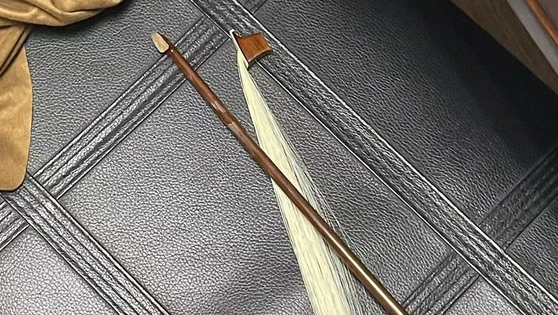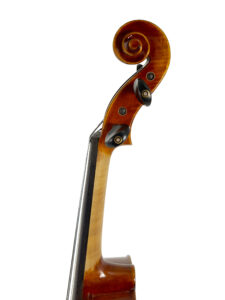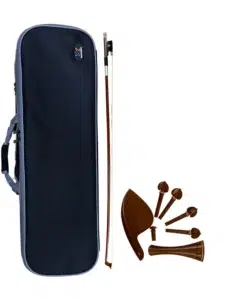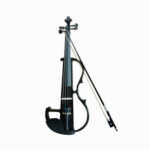During the process of playing the violin, proper maintenance techniques ensure that your violin maintains its optimal tone and appearance. The violin is an expensive and delicate instrument, so learning how to maintain it correctly is crucial. Below, we will introduce some key violin maintenance tips to help you preserve the beautiful tone and value of your violin.
Why Maintain the Violin?
The violin is a very fragile instrument and is greatly affected by its environment. Maintaining the violin ensures the stability of its sound quality and wood quality. A properly maintained violin will have better tone, more stable performance, and greater value. Proper maintenance also extends the lifespan of the violin, keeping its quality intact for many years.
How to Maintain the Violin Bow

Tighten the Bow
Before playing, it’s important to tighten the bow’s tension appropriately. Gently turn the screw, but don’t make the bow hair too tight—there should be a gap of about the width of a pencil between the bow stick and the hair.
Avoid Touching the Bow Hair with Fingers
When handling the bow, try to avoid touching the bow hair with your fingers or hand. Natural oils from the skin can affect the friction between the bow hair and the strings, impacting the sound.

Apply Rosin in Moderation
Before playing, apply an appropriate amount of rosin to the bow. Hold the rosin in your left hand, place the bow hair flat on the rosin, and then slowly move the bow back and forth on the rosin. Rosin increases the friction between the bow hair and the strings, producing sound.
Loosen the Bow After Playing
After playing, remember to loosen the bow hair. Keeping the bow in a tense state for a long time might cause the bow stick to deform, losing its curvature.
Can You Use Water to Clean the Violin?
Absolutely do not use water to clean the violin. The wood and varnish of the violin are highly sensitive to water, which can cause wood deformation, varnish damage, and even loosen the tuning pegs. If cleaning is necessary, it’s best to use a soft cloth specifically designed for string instruments, but be cautious not to apply excessive force to avoid damaging the varnish.
Shoulder Rest and Rosin
Using the Right Shoulder Rest

Using an appropriate shoulder rest helps prevent damage to the violin. The material of the shoulder rest should be durable and suitable for your violin and playing style. Choosing the right shoulder rest can reduce pressure while playing and prevent unnecessary buzzing.
Applying Rosin Regularly
Rosin is another essential factor during violin play and needs regular reapplication. The quantity of rosin you use will vary depending on humidity, so observe and adjust periodically. Proper rosin application enhances friction between the bow hair and strings, ensuring clear sound production.
Violin Bow and Bow Bugs
The violin bow is an indispensable part of playing, directly affecting tone and performance. Proper maintenance and use of the violin bow can enhance playing quality and instrument longevity.
Maintenance of the Bow Hair:

Bow hair is a critical part of the violin bow, contacting the strings to produce sound. After use, the bow hair should be gently loosened to reduce tension. This helps maintain the bow hair’s elasticity and lifespan. Regularly inspect the bow hair for breakage, wear, or damage, and replace as necessary.
After using the violin bow, gently wipe off rosin residue and sweat from the bow hair using a clean cloth. This helps keep the bow hair’s surface smooth and ensures good contact with the strings.
Maintenance of the Bow Stick:
The bow stick is the primary supporting part of the bow and requires proper protection and maintenance. Avoid placing the bow in overly humid or dry environments to prevent bow stick deformation or cracking. Additionally, avoid exposing the bow to direct sunlight to prevent heat-induced bow stick deformation.
Prevention and Treatment of Bow Bugs:
Bow bugs are a common issue; they are insect larvae that can hide between the bow hair. They may consume the bow hair, affecting its elasticity and structure. Preventive measures include regularly checking for signs of insects, avoiding placing the bow in damp and unclean environments, and periodically cleaning the bow hair and stick.
If bow bugs are discovered in the bow hair, take immediate action. A common method is to place the bow in a sealed plastic bag and then put it in the freezer; this will kill the bugs. Gradually thaw the bow at room temperature to ensure the bow hair doesn’t become damp.
For severe cases, it’s best to have the bow treated by a professional repair technician to ensure bow hair quality and lifespan. The violin bow is a crucial tool for violin performance; proper maintenance extends its lifespan while ensuring stable tone and performance quality. Regular checks, cleaning, and maintenance keep your violin bow in optimal condition.
Violin Bridge Adjustment
Regularly Check Bridge Position
Regularly check if the violin bridge is in the correct position to ensure stability and proper alignment. The installation of the violin bridge is a key aspect of maintaining its beautiful tone. Incorrect bridge placement can affect string tension and tone.
Ensure Bridge and Soundpost Stability
The bridge, strings, and soundpost are all vital components of the violin’s sound and should be regularly checked for stability. If any of these elements become unstable, they can impact the violin’s tone and performance.

Wipe Down After Playing
Use a Dry Soft Cloth to Wipe Down
After each playing session, gently wipe down the violin with a dry, soft cloth to remove rosin residue, dust, oils, or sweat from the strings. This helps maintain the cleanliness and appearance of the violin.
Clean the Strings
Use specialized string cleaner and a separate cloth to clean the violin strings. This helps remove dirt, dust, and other particles that may affect the string’s sound quality. Regularly cleaning the strings can extend their lifespan.
Do You Oil Your Violin?
When it comes to oiling your violin, this is generally a controversial topic. Oiling the violin as part of maintenance is a complex and carefully considered practice. The following will explore the question of whether or not to oil your violin and provide detailed information on the topic.
Do You Need to Oil Your Violin?
Oiling involves applying a protective coating to the surface of the violin. This coating can protect the varnish, preventing it from being exposed to external influences. The decision of whether or not to oil your violin depends on several factors, including personal preferences, the violin’s age, history, and the type of varnish used.
Age and History:
For some old violins, especially those with historical value, oiling can be a contentious issue. This is because oiling might alter the instrument’s sound, appearance, and value. For older violins, some professional players and collectors may avoid oiling to preserve the instrument’s original state.
Type of Varnish:
Different varnishes react differently to oils. Some varnishes may interact with certain lubricants, leading to discoloration or damage. Therefore, when considering oiling your violin, it’s essential to first understand the type of varnish used and seek advice from professionals.
Personal Preferences:
Some players and makers believe that oiling can add a layer of protection to the violin, making it more durable and improving its appearance. However, others may believe that the violin should remain in its original state to avoid unpredictable effects on its appearance and sound.
Techniques and Considerations for Oiling:
If you decide to oil your violin, here are some techniques and considerations to keep in mind:
- Choose Appropriate Lubricant:
Select lubricants specifically designed for instruments, avoiding products with harmful ingredients. Steer clear of products containing solvents or harsh chemicals.
- Frequency of Oiling:
If you choose to oil your violin, avoid doing so too frequently. Generally, oiling should not be done more than once every quarter. Over-oiling can make the instrument feel sticky or lose its original texture.
- Application Method:
Gently wipe the lubricant with a clean, soft cloth, applying it evenly to the surface of the violin. Avoid excessive residue to prevent altering the appearance.
- Consult Professionals:
If you’re unsure whether to oil your violin or how to do it correctly, it’s best to consult with professional violin makers, repair technicians, or teachers. They can offer advice based on your instrument’s specific circumstances.
Oiling your violin is a complex decision that requires consideration of multiple factors. Before making a decision, thoroughly understand your instrument, seek advice from professionals, and take action after careful consideration. Whether you choose to oil or not, maintaining the violin’s cleanliness, stability, and proper humidity management are crucial measures for protecting the instrument.
Storing Your Violin:
Proper storage and care are essential for maintaining the violin’s tone and appearance. Here are some suggestions on how to store your violin properly:

Choose a High-Quality Violin Case:
Using a high-quality violin case is the foundation for protecting your violin. An excellent case should be made from durable, shock-absorbent materials, with a soft interior providing stable support. Recommended brands include BAM, GEWA, among others, known for their reputation in violin protection.
Control Humidity and Temperature:
Violins are sensitive to humidity and temperature changes. To maintain consistent humidity and temperature, store the violin in an appropriate environment. Recommended temperature ranges from 18 to 25 degrees Celsius (64 to 77 degrees Fahrenheit), and relative humidity between 40% and 60%. Placing a hygrometer in the storage area allows you to monitor environmental changes.
Avoid Direct Sunlight:
Prolonged exposure to direct sunlight can damage the varnish and wood of the violin. Thus, try to keep the violin away from direct sunlight, especially near windows or outdoors.
Use Humidity Regulators:
If you live in a dry climate, consider using a humidity regulator specifically designed for violins to prevent the wood from becoming excessively dry and deforming. These regulators help maintain consistent humidity levels, contributing to the violin’s stability and tone.
With proper storage and maintenance, your violin will enjoy an extended lifespan and maintain its optimal tone. Choosing a quality case, maintaining proper humidity and temperature, avoiding sunlight exposure, and using humidity regulators are key to keeping your violin in its best condition.
How Often Should You Maintain the Violin?
The frequency of violin maintenance depends on your usage and environmental conditions. It’s generally recommended to check the violin’s condition at least once a month to ensure elements like strings, bridge, and soundpost are in the correct positions and stable.
Summary
Maintaining the violin is crucial for preserving its tone, stability, and value. Through proper maintenance methods, you can ensure your violin maintains exceptional performance for years to come. By following the aforementioned violin maintenance tips, you’ll help sustain the beautiful tone and appearance of your instrument, while extending its lifespan to accompany you on a longer musical journey. Remember, violin maintenance requires patience and attention to detail—it’s well worth it as it enhances your playing experience.






